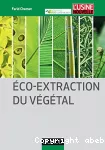Adresse
Infodoc : Réseau des bibliothèques et centres de documentation d'AgroParisTechFrance
contact

Détail de l'auteur
Auteur Farid Chemat
Commentaire :
Professeur des universités à l'Université d'Avignon et des Pays de Vaucluse, responsable du laboratoire et plateforme GREEN (Groupe de recherche en éco-extraction des produits naturels)
|
Documents disponibles écrits par cet auteur (2)
 Ajouter le résultat dans votre panier Faire une suggestion Affiner la recherche Interroger des sources externes
Ajouter le résultat dans votre panier Faire une suggestion Affiner la recherche Interroger des sources externes
 Livre69 EUR
Livre69 EUR978-2-10-072209-91 vol. (XI-322 p.)
1 vol. (XI-322 p.)Prix : 69 EUR ISBN : 978-2-10-072209-9 
 Livre
Livre978-0-12-815353-61 vol. (XIX-562 p.)
1 vol. (XIX-562 p.)ISBN : 978-0-12-815353-6




